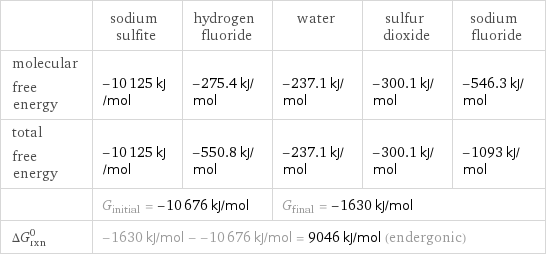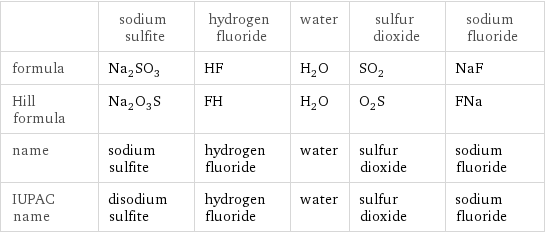Input interpretation

Na_2SO_3 sodium sulfite + HF hydrogen fluoride ⟶ H_2O water + SO_2 sulfur dioxide + NaF sodium fluoride
Balanced equation

Balance the chemical equation algebraically: Na_2SO_3 + HF ⟶ H_2O + SO_2 + NaF Add stoichiometric coefficients, c_i, to the reactants and products: c_1 Na_2SO_3 + c_2 HF ⟶ c_3 H_2O + c_4 SO_2 + c_5 NaF Set the number of atoms in the reactants equal to the number of atoms in the products for Na, O, S, F and H: Na: | 2 c_1 = c_5 O: | 3 c_1 = c_3 + 2 c_4 S: | c_1 = c_4 F: | c_2 = c_5 H: | c_2 = 2 c_3 Since the coefficients are relative quantities and underdetermined, choose a coefficient to set arbitrarily. To keep the coefficients small, the arbitrary value is ordinarily one. For instance, set c_1 = 1 and solve the system of equations for the remaining coefficients: c_1 = 1 c_2 = 2 c_3 = 1 c_4 = 1 c_5 = 2 Substitute the coefficients into the chemical reaction to obtain the balanced equation: Answer: | | Na_2SO_3 + 2 HF ⟶ H_2O + SO_2 + 2 NaF
Structures

+ ⟶ + +
Names

sodium sulfite + hydrogen fluoride ⟶ water + sulfur dioxide + sodium fluoride
Reaction thermodynamics
Enthalpy

| sodium sulfite | hydrogen fluoride | water | sulfur dioxide | sodium fluoride molecular enthalpy | -1101 kJ/mol | -273.3 kJ/mol | -285.8 kJ/mol | -296.8 kJ/mol | -576.6 kJ/mol total enthalpy | -1101 kJ/mol | -546.6 kJ/mol | -285.8 kJ/mol | -296.8 kJ/mol | -1153 kJ/mol | H_initial = -1647 kJ/mol | | H_final = -1736 kJ/mol | | ΔH_rxn^0 | -1736 kJ/mol - -1647 kJ/mol = -88.43 kJ/mol (exothermic) | | | |
Gibbs free energy

| sodium sulfite | hydrogen fluoride | water | sulfur dioxide | sodium fluoride molecular free energy | -10125 kJ/mol | -275.4 kJ/mol | -237.1 kJ/mol | -300.1 kJ/mol | -546.3 kJ/mol total free energy | -10125 kJ/mol | -550.8 kJ/mol | -237.1 kJ/mol | -300.1 kJ/mol | -1093 kJ/mol | G_initial = -10676 kJ/mol | | G_final = -1630 kJ/mol | | ΔG_rxn^0 | -1630 kJ/mol - -10676 kJ/mol = 9046 kJ/mol (endergonic) | | | |
Equilibrium constant
![Construct the equilibrium constant, K, expression for: Na_2SO_3 + HF ⟶ H_2O + SO_2 + NaF Plan: • Balance the chemical equation. • Determine the stoichiometric numbers. • Assemble the activity expression for each chemical species. • Use the activity expressions to build the equilibrium constant expression. Write the balanced chemical equation: Na_2SO_3 + 2 HF ⟶ H_2O + SO_2 + 2 NaF Assign stoichiometric numbers, ν_i, using the stoichiometric coefficients, c_i, from the balanced chemical equation in the following manner: ν_i = -c_i for reactants and ν_i = c_i for products: chemical species | c_i | ν_i Na_2SO_3 | 1 | -1 HF | 2 | -2 H_2O | 1 | 1 SO_2 | 1 | 1 NaF | 2 | 2 Assemble the activity expressions accounting for the state of matter and ν_i: chemical species | c_i | ν_i | activity expression Na_2SO_3 | 1 | -1 | ([Na2SO3])^(-1) HF | 2 | -2 | ([HF])^(-2) H_2O | 1 | 1 | [H2O] SO_2 | 1 | 1 | [SO2] NaF | 2 | 2 | ([NaF])^2 The equilibrium constant symbol in the concentration basis is: K_c Mulitply the activity expressions to arrive at the K_c expression: Answer: | | K_c = ([Na2SO3])^(-1) ([HF])^(-2) [H2O] [SO2] ([NaF])^2 = ([H2O] [SO2] ([NaF])^2)/([Na2SO3] ([HF])^2)](../image_source/b2bf168e5134794d10f725744bd28e53.png)
Construct the equilibrium constant, K, expression for: Na_2SO_3 + HF ⟶ H_2O + SO_2 + NaF Plan: • Balance the chemical equation. • Determine the stoichiometric numbers. • Assemble the activity expression for each chemical species. • Use the activity expressions to build the equilibrium constant expression. Write the balanced chemical equation: Na_2SO_3 + 2 HF ⟶ H_2O + SO_2 + 2 NaF Assign stoichiometric numbers, ν_i, using the stoichiometric coefficients, c_i, from the balanced chemical equation in the following manner: ν_i = -c_i for reactants and ν_i = c_i for products: chemical species | c_i | ν_i Na_2SO_3 | 1 | -1 HF | 2 | -2 H_2O | 1 | 1 SO_2 | 1 | 1 NaF | 2 | 2 Assemble the activity expressions accounting for the state of matter and ν_i: chemical species | c_i | ν_i | activity expression Na_2SO_3 | 1 | -1 | ([Na2SO3])^(-1) HF | 2 | -2 | ([HF])^(-2) H_2O | 1 | 1 | [H2O] SO_2 | 1 | 1 | [SO2] NaF | 2 | 2 | ([NaF])^2 The equilibrium constant symbol in the concentration basis is: K_c Mulitply the activity expressions to arrive at the K_c expression: Answer: | | K_c = ([Na2SO3])^(-1) ([HF])^(-2) [H2O] [SO2] ([NaF])^2 = ([H2O] [SO2] ([NaF])^2)/([Na2SO3] ([HF])^2)
Rate of reaction
![Construct the rate of reaction expression for: Na_2SO_3 + HF ⟶ H_2O + SO_2 + NaF Plan: • Balance the chemical equation. • Determine the stoichiometric numbers. • Assemble the rate term for each chemical species. • Write the rate of reaction expression. Write the balanced chemical equation: Na_2SO_3 + 2 HF ⟶ H_2O + SO_2 + 2 NaF Assign stoichiometric numbers, ν_i, using the stoichiometric coefficients, c_i, from the balanced chemical equation in the following manner: ν_i = -c_i for reactants and ν_i = c_i for products: chemical species | c_i | ν_i Na_2SO_3 | 1 | -1 HF | 2 | -2 H_2O | 1 | 1 SO_2 | 1 | 1 NaF | 2 | 2 The rate term for each chemical species, B_i, is 1/ν_i(Δ[B_i])/(Δt) where [B_i] is the amount concentration and t is time: chemical species | c_i | ν_i | rate term Na_2SO_3 | 1 | -1 | -(Δ[Na2SO3])/(Δt) HF | 2 | -2 | -1/2 (Δ[HF])/(Δt) H_2O | 1 | 1 | (Δ[H2O])/(Δt) SO_2 | 1 | 1 | (Δ[SO2])/(Δt) NaF | 2 | 2 | 1/2 (Δ[NaF])/(Δt) (for infinitesimal rate of change, replace Δ with d) Set the rate terms equal to each other to arrive at the rate expression: Answer: | | rate = -(Δ[Na2SO3])/(Δt) = -1/2 (Δ[HF])/(Δt) = (Δ[H2O])/(Δt) = (Δ[SO2])/(Δt) = 1/2 (Δ[NaF])/(Δt) (assuming constant volume and no accumulation of intermediates or side products)](../image_source/4444eebe88d7e4e428df46e30eb49164.png)
Construct the rate of reaction expression for: Na_2SO_3 + HF ⟶ H_2O + SO_2 + NaF Plan: • Balance the chemical equation. • Determine the stoichiometric numbers. • Assemble the rate term for each chemical species. • Write the rate of reaction expression. Write the balanced chemical equation: Na_2SO_3 + 2 HF ⟶ H_2O + SO_2 + 2 NaF Assign stoichiometric numbers, ν_i, using the stoichiometric coefficients, c_i, from the balanced chemical equation in the following manner: ν_i = -c_i for reactants and ν_i = c_i for products: chemical species | c_i | ν_i Na_2SO_3 | 1 | -1 HF | 2 | -2 H_2O | 1 | 1 SO_2 | 1 | 1 NaF | 2 | 2 The rate term for each chemical species, B_i, is 1/ν_i(Δ[B_i])/(Δt) where [B_i] is the amount concentration and t is time: chemical species | c_i | ν_i | rate term Na_2SO_3 | 1 | -1 | -(Δ[Na2SO3])/(Δt) HF | 2 | -2 | -1/2 (Δ[HF])/(Δt) H_2O | 1 | 1 | (Δ[H2O])/(Δt) SO_2 | 1 | 1 | (Δ[SO2])/(Δt) NaF | 2 | 2 | 1/2 (Δ[NaF])/(Δt) (for infinitesimal rate of change, replace Δ with d) Set the rate terms equal to each other to arrive at the rate expression: Answer: | | rate = -(Δ[Na2SO3])/(Δt) = -1/2 (Δ[HF])/(Δt) = (Δ[H2O])/(Δt) = (Δ[SO2])/(Δt) = 1/2 (Δ[NaF])/(Δt) (assuming constant volume and no accumulation of intermediates or side products)
Chemical names and formulas

| sodium sulfite | hydrogen fluoride | water | sulfur dioxide | sodium fluoride formula | Na_2SO_3 | HF | H_2O | SO_2 | NaF Hill formula | Na_2O_3S | FH | H_2O | O_2S | FNa name | sodium sulfite | hydrogen fluoride | water | sulfur dioxide | sodium fluoride IUPAC name | disodium sulfite | hydrogen fluoride | water | sulfur dioxide | sodium fluoride